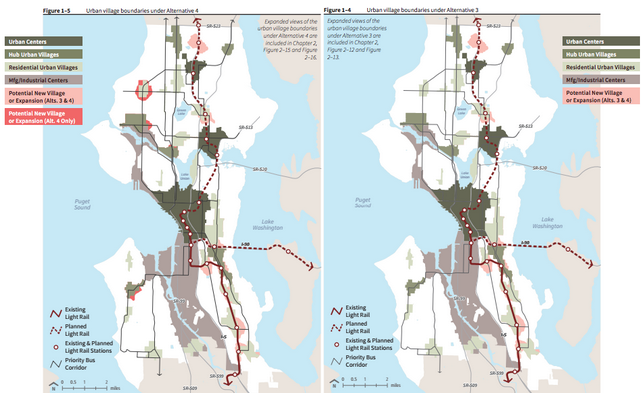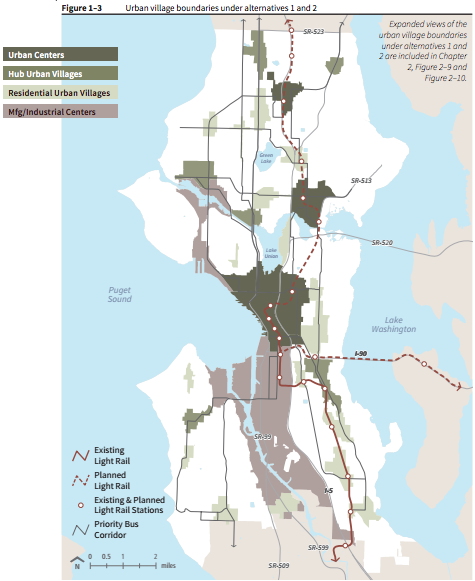
The City of Seattle is quickly approaching the completion of its review and update of the city’s Comprehensive Plan. Earlier this month, the City released its Draft Environmental Impact Statement (DEIS), which analyzed four differing alternatives. As part of this, the City has opened up a 45-day comment period for the public to submit their comments. City staff will listen to comments received by the public and further refine the proposed alternatives in a Final Environment Impact Statement. The City Council must ultimately adopt a set of updated policies and regulatory changes based upon a preferred set of alternatives.

Stephen previously shared the high level details of the DEIS alternatives, which can broadly be summarized as follows:
- Alternative 1 is an approach to growth that targets land use development in the same patterns we’ve seen over the past 20 years. It focuses new job growth in Downtown Seattle and South Lake Union while residential growth takes place in urban centers and urban villages. It assumes that market trends remains generally the same as today.
- Alternative 2 guides growth to the city’s established urban centers. It assume that these centers will become even more dominant destinations for new residents and jobs than previous decades. It has the benefit of further encouraging people to walk and bike while reducing their dependence on driving.
- Alternative 3 focuses growth in the city’s urban villages near light rail and urban centers. While growth in urban centers remains important in this alternative, special emphasis is placed on accommodating much of the growth in urban villages where they are–or will be–served by light rail transit. Boundary changes are possible within 10-minute walksheds of existing and planned light rail stations. For instance, a new urban village could be designated at I-5 and NE 130th St during the plan period while a reconfiguration of the Mount Baker and Jackson-23rd & Union urban villages could occur in conjunction with the opening of a light rail station at I-90.
- Alternative 4 envisions growth for urban villages near frequent transit, which includes both high quality bus and rail service–not just light rail. More urban villages would be slated for increased growth capacity than conceived by Alternative 3, including expanded urban villages in Ballard, Crown Hill, Fremont, and Alaska Junction.
The Department of Planning and Development (DPD) has put together a useful online open house for the public to review the project proposals. DPD also will hold a public hearing tomorrow evening (May 27, 2015) at the Bertha Knight Landes Room from 6pm to 8pm. This venue is located right at City Hall.
However, public comment will remain open through June 18, 2015 and be considered in addition to vocal testimony. Written comments can be sumbitted online, through a survey, at 2035@seattle.gov, or mailed to DPD.
Our Board hasn’t yet endorsed one particular alternative yet, but we plan to do so in following weeks.
The Urbanist was founded in 2014 to examine and influence urban policies. We believe cities provide unique opportunities for addressing many of the most challenging social, environmental, and economic problems. We serve as a resource for promoting and disseminating ideas, creating community, increasing political participation, and improving the places we live.



